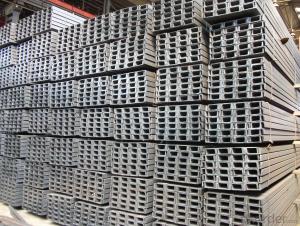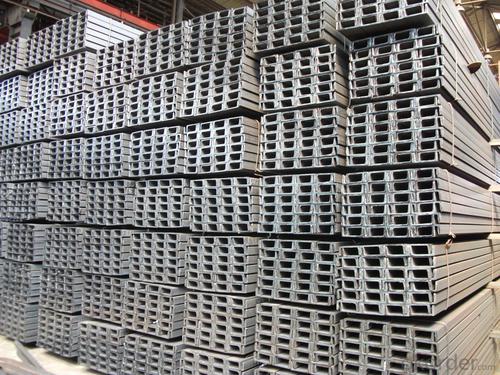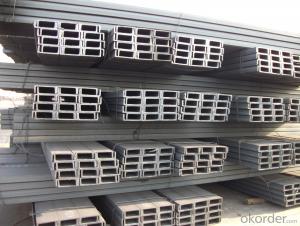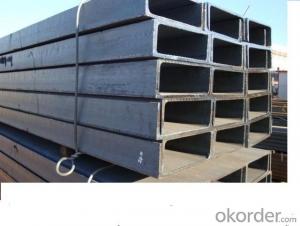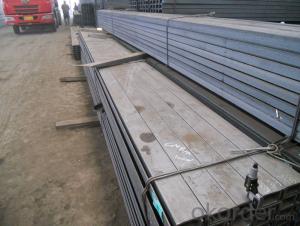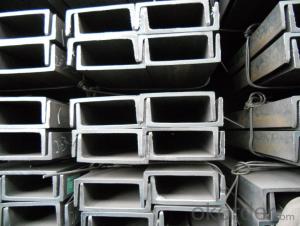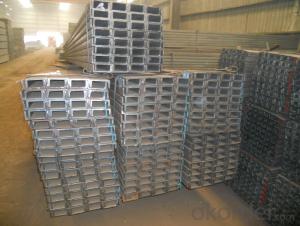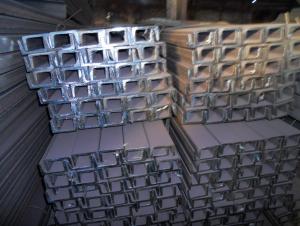High Quality 18# Steel Channel
- Loading Port:
- China Main Port
- Payment Terms:
- TT OR LC
- Min Order Qty:
- -
- Supply Capability:
- -
OKorder Service Pledge
OKorder Financial Service
You Might Also Like
Steel Channel
Standard: GB
Material: Q235
Length: 6m, 12m
Size:
| Size (mm) | Mass (Kg/m) |
| 180*68*7.0 | 20.174 |
| 180*70*9.0 | 23.000 |
The chemical composition of HR Channel Steel according to Q235B is shown in Table-1.
Alloy No | Grade | Element(%) | ||||
C | Mn | S | P | Si | ||
Q235 | B | 0.12-0.20 | 0.3-0.7 | ≦0.045 | ≦0.045 | ≦0.3 |
Table-1
Note: we are able to present our customers relevant SGS test report for chemical composition of HR Channel Steel.
The mechanical property of HR Channel Steel according to Q235B is shown in Table-2
Alloy No | Grade | Yielding Strength Point(Mpa) | |||
Thickness(mm) | |||||
≦16 | >16-40 | >40-60 | >60-100 | ||
≧ | |||||
Q235 | B | 235 | 225 | 215 | 205 |
Table-2
Package & Delivery of MS Channel:
1.The hot rolled channel steel will be packed in bundle with steel wire at each end of every bundle and color marking in order to help the customer to recognize his goods more easily at sight.
2. And the hot rolled channel steel could be loaded into 20ft or 40ft container, or by bulk cargo.If the weight of each bundle reaches more than 3.5 mt, the loading by break bulk cargo should be choosed.When the weight of each bundle reaches less than 3mt, the loading by container should be choosed.
3.As for the transportaion from mill to loading port, the truck will be usually used. And the maximum quantity for each truck is 40mt.
4.All in all, we could do in accordance with customer's request.
*If you would like to get our price, please inform us the size, standard/material and quantity. Thank you very much for your attention.
- Q: Can steel channels be used for railway track support?
- Yes, steel channels can be used for railway track support. Steel channels are often used as a cost-effective and durable structural support element in various applications, including railway track support. They provide strength, stability, and load-bearing capacity, making them suitable for supporting the weight and forces exerted by trains on railway tracks. Steel channels can be easily fabricated and installed, and they have the ability to withstand harsh environmental conditions and heavy loads. Additionally, their inherent resistance to corrosion makes them a reliable choice for long-term use in railway track support systems.
- Q: What type of channel is used for the type of room with a span of 4 meters?
- I-beam, also called steel girder, is a long strip steel with cross section. The specifications are expressed by the height of the waist (H) * leg width (b) * waist thickness (d), such as "work 160*88*6", which means that the waist height is 160 mm, the width of the leg is 88 mm, and the thickness of the waist is 6 mm. The specifications of I-beam can also be expressed by type. The model indicates the height of centimeters, such as 16#. The same height of the I-beam, if there are several different leg width and waist thickness, should be added on the right side of the model a, B, C to distinguish, such as 32a#, 32b#, 32c# and so on. The I-beam is made of ordinary I-beam and light I-beam, and the specification for hot-rolled ordinary I-beam is 10-63#. Standard Specification for hot-rolled ordinary I-beam supplied by supply and demand agreement is 12-55#. I-beam is widely used in various building structures, bridges, vehicles, supports, machinery and so on.
- Q: What are the typical finishes available for steel channels?
- Steel channels can be finished in various ways to achieve different aesthetic and functional requirements. One option is to use hot-dip galvanizing, where the steel channel is immersed in molten zinc. This method not only provides excellent corrosion resistance but also adds a decorative touch with a shiny and even surface. Another choice is powder coating, which involves applying a dry powder onto the steel channel and then curing it with heat. This finish is highly durable and attractive, resistant to chipping, scratching, and fading. It can be customized in different colors to suit individual preferences and blend with the surroundings. Electroplating is also popular for steel channels. It entails immersing the channel in an electrolyte solution and passing an electric current through it, resulting in a layer of metal (such as chrome or nickel) being deposited on the surface. This process enhances the appearance of the channel with a smooth and shiny finish while providing some corrosion resistance. For a more natural and rustic look, steel channels can be left unfinished or with a bare metal finish. This option is often chosen for industrial or architectural designs where the raw and exposed metal is desired for its aesthetic appeal. In conclusion, the available finishes for steel channels include hot-dip galvanizing, powder coating, electroplating, and bare metal finishes. Each finish offers its own unique benefits in terms of corrosion resistance, durability, appearance, and customization options, providing a wide range of applications and design possibilities.
- Q: Are steel channels suitable for seismic zones?
- Yes, steel channels are suitable for seismic zones. Steel channels, also known as C-channels or U-channels, are commonly used in seismic design and construction due to their structural strength and flexibility. Steel has a high strength-to-weight ratio, which makes it ideal for withstanding seismic forces. Additionally, steel channels can be designed and engineered to have the necessary stiffness and ductility to absorb and dissipate energy during an earthquake. This helps to reduce the impact of seismic shaking on the overall structure, making it more resilient and less prone to damage. Steel channels also provide excellent fire resistance, which is an important consideration in seismic zones. Overall, steel channels are a popular choice for seismic design and construction due to their durability, flexibility, and ability to withstand seismic forces.
- Q: How do steel channels contribute to the durability of a structure?
- Steel channels contribute to the durability of a structure in several ways. Firstly, steel channels are made from a high-strength material which provides excellent resistance to external forces. This means that they can withstand heavy loads, impacts, and vibrations without deforming or breaking, ensuring the structural integrity of the building. Secondly, steel channels are designed with specific shapes and dimensions, allowing them to distribute the loads evenly across the structure. This helps in preventing localized stress concentrations, reducing the risk of fatigue failure over time. By evenly distributing the forces, steel channels can also minimize the potential for cracks or structural deformations, enhancing the long-term durability of the structure. Furthermore, steel channels offer superior corrosion resistance compared to other materials like wood or concrete. Steel is often protected with coatings or galvanized to prevent rust and corrosion, which can significantly extend the lifespan of the structure. This resistance to corrosion is particularly important in environments with high humidity, exposure to saltwater, or industrial pollutants. Another advantage of steel channels is their versatility and adaptability in construction. They can be easily fabricated and customized to fit the specific needs of a structure, including size, shape, and connection details. This flexibility allows for efficient construction and the ability to modify or expand the structure in the future without compromising its overall durability. Lastly, steel channels offer fire resistance, which is crucial for the safety and durability of a structure. Steel has a high melting point and does not contribute to the spread of fire, providing valuable time for occupants to evacuate and minimizing damage to the building. This fire resistance also reduces the need for extensive fireproofing measures, making steel channels a cost-effective solution for enhancing the durability of a structure. In summary, steel channels contribute to the durability of a structure by providing high-strength, even load distribution, corrosion resistance, versatility, and fire resistance. These qualities help ensure the longevity and safety of the building, making steel channels a valuable component in construction.
- Q: Can steel channels be galvanized?
- Indeed, it is possible to galvanize steel channels. Galvanization is a technique utilized to shield steel from rusting and corrosion by applying a safeguarding zinc coating. By galvanizing steel channels, one can attain long-lasting protection, which can be achieved through either hot-dip galvanizing or electroplating methods. In the hot-dip galvanizing process, the steel channel is submerged in a bath of molten zinc, while electroplating involves depositing a layer of zinc onto the steel surface using an electric current. Due to their augmented resilience and ability to withstand environmental elements, galvanized steel channels find wide utilization across diverse industries, including construction, infrastructure, and manufacturing.
- Q: Can steel channels be used in solar panel installations?
- Yes, steel channels can be used in solar panel installations. They provide structural support and stability to the panels, allowing for secure mounting on roofs or other surfaces. Steel channels are durable and can withstand the weight and environmental conditions associated with solar panel installations, making them a suitable choice for this purpose.
- Q: How do steel channels contribute to energy efficiency in buildings?
- Steel channels contribute to energy efficiency in buildings in several ways. Firstly, steel channels are often used in the construction of thermal insulation systems. These systems help to reduce heat transfer through walls and roofs, thereby minimizing the need for heating or cooling and lowering energy consumption. Additionally, steel channels are commonly utilized in the framing of windows and doors, providing structural support and enhancing the overall energy performance of the building envelope. Furthermore, steel channels can be incorporated into HVAC (Heating, Ventilation, and Air Conditioning) systems, enabling efficient air distribution and minimizing energy wastage. Overall, the use of steel channels in building construction plays a crucial role in enhancing energy efficiency and reducing environmental impact.
- Q: What are the applications of steel channels in construction?
- Due to their strength, durability, and versatility, steel channels are widely used in construction for a variety of purposes. The following are some key applications of steel channels in construction: 1. Structural Support: Steel channels are commonly employed to provide structural support in buildings, bridges, and other infrastructure projects. They can be utilized as beams or columns to effectively carry loads and distribute weight. 2. Framing: Steel channels are frequently utilized in framing applications, particularly for walls, ceilings, and roofs. They offer a robust and dependable framework that ensures the stability and integrity of the structure. 3. Staircases and Handrails: Steel channels are an ideal choice for constructing staircases and handrails due to their strength and rigidity. They provide a safe and durable solution, especially in areas with high foot traffic. 4. Reinforcement: Steel channels can be used to reinforce concrete structures, such as foundations, walls, and slabs. By incorporating steel channels, the strength and load-bearing capacity of the concrete are significantly enhanced. 5. Mezzanine Floors: Steel channels are commonly used to create mezzanine floors, which provide additional space in buildings without the need to expand the footprint. Steel channels offer a lightweight yet sturdy solution for supporting the floor structure. 6. Industrial Racks and Shelves: Steel channels are extensively used in the construction of industrial racks and shelves. Their ability to bear heavy loads and their durability make them suitable for storing heavy equipment, materials, and products. 7. Infrastructure Projects: Steel channels find widespread applications in large-scale infrastructure projects, including bridges, tunnels, and railways. Their high strength-to-weight ratio makes them ideal for withstanding heavy loads and resisting environmental factors. 8. Architectural Design: Steel channels are commonly employed in architectural design to create unique and aesthetically pleasing structures. They can be shaped and welded into various configurations, allowing architects to bring their creative visions to life. Overall, steel channels are of utmost importance in the construction industry, providing a dependable, durable, and versatile solution for various applications. Their strength, load-bearing capacity, and flexibility make them indispensable in modern construction projects.
- Q: How can channel A and B be distinguished?
- In general, B is thicker than a and 2mm thick.
Send your message to us
High Quality 18# Steel Channel
- Loading Port:
- China Main Port
- Payment Terms:
- TT OR LC
- Min Order Qty:
- -
- Supply Capability:
- -
OKorder Service Pledge
OKorder Financial Service
Similar products
Hot products
Hot Searches
Related keywords
